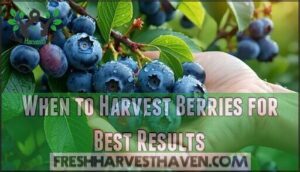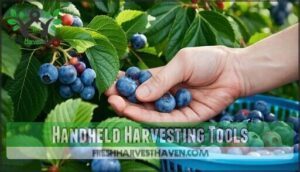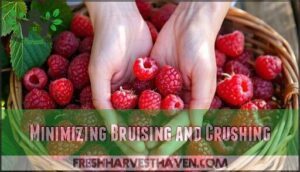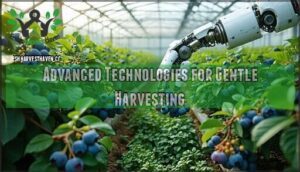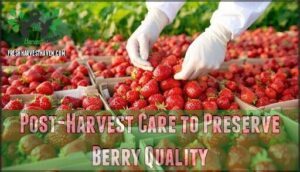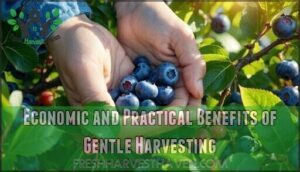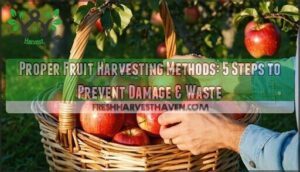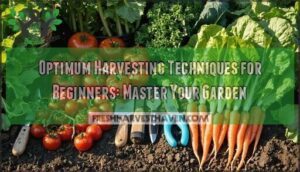This site is supported by our readers. We may earn a commission, at no cost to you, if you purchase through links.
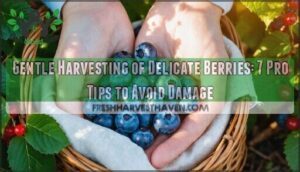
Use soft-lined containers and cradle each berry—no squeezing or tossing. Watch for easy detachment from the stem, a sure sign of peak ripeness.
Cool berries quickly, and don’t pile them high; even the lightest stack squashes the bottom row. A sharp pair of clean shears for stubborn fruit beats yanking every time.
There’s an art to it, but soon you’ll handle berries like a seasoned picker.
Table Of Contents
- Key Takeaways
- What Makes Berries Delicate?
- When to Harvest Berries for Best Results
- Essential Tools for Gentle Berry Harvesting
- Manual Techniques to Prevent Berry Damage
- Advanced Technologies for Gentle Harvesting
- Post-Harvest Care to Preserve Berry Quality
- Economic and Practical Benefits of Gentle Harvesting
- Frequently Asked Questions (FAQs)
- What is it called when you pick berries?
- What month is best for berry picking?
- Can blackberries be picked by machine?
- What time of day do you harvest berries?
- How do weather conditions affect berry firmness?
- What causes berries to lose their natural flavor?
- When should I stop watering before harvesting?
- How do I identify pest damage on berries?
- What soil amendments improve berry texture and taste?
- Are there organic-approved methods for gentle berry harvesting?
- Conclusion
Key Takeaways
- Harvest berries in the early morning when they’re coolest and firmest to reduce the risk of bruising.
- Always use a gentle touch, soft-lined containers, and avoid overfilling to keep your berries intact.
- Choose the right tools—sharp shears for tough stems and shallow, breathable baskets for collection.
- Cool berries quickly after picking and store them in single layers to maintain freshness and flavor.
What Makes Berries Delicate?
You’ll find that berries have thin skins, soft flesh, and weak attachment points that make them break easily during harvest.
Their high water content and delicate cell walls mean even light pressure can cause bruising, juice loss, or structural damage that reduces market value.
Common Fragile Berry Varieties
Berry farmers know certain varieties demand extra care during harvest. Each type presents unique challenges that require specific gentle handling techniques.
- Strawberry Cultivars: Soft skin bruises easily, requiring light finger pressure
- Raspberry Types: Hollow structure collapses under pressure, needs delicate touch
- Blueberry Sensitivity: Waxy bloom protects fruit but wipes off with rough handling
- Blackberry Fragility: Individual drupelets separate when squeezed too hard
Use breathable containers and harvest at peak ripeness for best results.
Why Gentle Handling Matters
Rough handling damages berry cell walls, causing juice leakage and rapid spoilage. When you harvest at peak ripeness using gentle handling techniques, you preserve berry nutrients and improve berry flavor. Minimizing bruising impact through proper fruit harvesting techniques extends shelf life considerably.
Blackberry harvesting requires extra care since these fruits are particularly vulnerable to crushing. Reduced berry spoilage means better profits and happier customers.
When to Harvest Berries for Best Results
You’ll get the best results when you harvest berries at their peak ripeness, which varies by variety and depends on color, firmness, and ease of removal from the stem.
Timing your harvest for early morning hours, when temperatures are cool and berries contain less heat stress, helps preserve their delicate structure and extends shelf life.
Signs of Ripeness in Different Berries
When berry coloration reaches full maturity, you’ll know it’s harvest time. Strawberries show uniform red color with no white patches, while blackberries turn deep black with matte finish.
Size matters too—fully developed berries feel plump but firm. Check stem condition; ripe berries detach easily during gentle pulling.
Taste testing confirms sweetness levels, and proper seed development indicates readiness for best fruit harvesting techniques. To encourage continued production, remember to pick berries often.
Timing and Weather Considerations
Best harvest timing depends on temperature effects and weather impact. Harvest in the morning after dew evaporates when berries are firmest. High temperatures soften fruit, while cool conditions preserve quality.
Microclimate management affects ripening—temperatures between 68-77°F promote growth. Seasonal variations and frost damage affect fruit ripening processes. Consider vine fruit harvesting differs from tree fruit harvesting needs.
To make the best flavor, consider berry harvesting criteria such as color and smell.
Essential Tools for Gentle Berry Harvesting
You’ll need the right tools to harvest berries without crushing their delicate skin or damaging the fruit structure. From simple handheld containers to sophisticated robotic grippers with sensors, choosing proper equipment makes the difference between bruised berries and premium produce.
Handheld Harvesting Tools
Small harvesting containers with soft basket liners protect berries from bruising during collection. Ergonomic tool design reduces hand strain during long picking sessions.
Sharp, clean pruning shears help with vine fruit harvesting, while picking aprons keep your hands free. Tool sterilization prevents disease spread between plants.
Choose lightweight containers for tree fruit harvesting comfort.
Mechanical and Robotic Innovations
While handheld tools work well for small operations, robotic advancements are revolutionizing berry harvesting. Soft robotic grippers use sensor technology for gentle gripping without crushing delicate fruit.
These autonomous robotic systems deliver harvesting efficiency that matches human workers while maintaining consistent quality. Automation benefits include reduced labor costs and improved yield preservation.
Soft robotics technology represents what’s coming in gentle, damage-free berry collection.
Manual Techniques to Prevent Berry Damage
Your hands are the most precise tools for berry harvesting, but they need proper technique to avoid damage.
You’ll use specific finger movements and grip methods that protect the fruit’s delicate skin while ensuring clean separation from the stem.
Proper Picking Methods
When picking berries, your gentle touch makes all the difference in preserving fruit quality. Hand placement near the stem prevents crushing, while soft container handling protects delicate skins.
Follow these best practices:
- Use picking timing during cool morning hours
- Steady berries with fingertips, not palms
- Place fruit gently into shallow containers
- Apply mild pressure when detaching stems
- Practice gentle sorting as you pick
Minimizing Bruising and Crushing
Several key handling techniques prevent berry damage during harvest. Use a gentle touch with minimal finger pressure – think feather-light contact rather than firm grips. Prop up each berry from underneath while picking to reduce stress on attachment points.
Collect berries in shallow containers to avoid crushing lower layers. These bruise prevention methods and crush reduction strategies preserve fruit quality through proper equipment design and best pressure application.
Advanced Technologies for Gentle Harvesting
These days, harvesting machines are a lot smarter—they use soft robotics and built-in sensors to figure out just when berries are perfectly ripe. The machines gently pick them using just the right amount of pressure, so there’s no damage.
Air-powered harvesters and similar setups can cut labor costs by as much as 80%, all while keeping fruit quality as high as what you’d get with careful hand-picking.
With tools like air-powered harvesters, it’s now possible to cut your labor costs by up to 80%—all without sacrificing fruit quality.
These newer machines are so precise that the berries stay just as flawless as if they’d been picked by hand.
Soft Robotics and Sensorized Grippers
Soft robotic grippers these days are designed to be gentle, thanks to silicone materials that feel a lot like human skin. By weaving in sensors, they can actually tell how ripe a berry is—getting it right 94% of the time—while making sure not to squeeze too hard.
Real-time force sensors help the robot adjust its touch on the fly, kind of like how we pick berries ourselves. The way these systems work is a lot like the precision of minimally invasive surgery, helping keep the fruit safe from damage.
Force sensors are like the robot’s sense of touch, constantly giving it feedback as it picks. This lets the robot adjust its grip on the spot, a bit like how we’d change how hard we squeeze a berry without even thinking about it.
The real magic here is damage prevention—the same careful precision you see in minimally invasive surgery, but now helping machines handle fruit gently and safely.
Air and Pneumatic Harvesters
Pneumatic gripping takes soft robotic grippers a step further, giving us a smarter way to harvest fruit. Instead of grabbing berries, these systems use gentle, controlled bursts of air to pick them up—never even touching the fruit.
That airflow creates just enough suction to lift each berry while keeping them aired out and free from damage. It’s a game changer for delicate crops, especially tropical fruits that bruise easily.
Using gentle puffs of air, these robotic grippers can lift fruit without even touching it, letting the berries stay cushioned and well aerated as they’re picked. The mild suction is just enough to separate each berry from the plant—no squeezing, no bruising.
This approach really shines with sensitive crops, especially tropical fruits, where a softer touch can make all the difference to overall quality.
Post-Harvest Care to Preserve Berry Quality
Once you’ve harvested your berries, you can’t relax yet because proper post-harvest care determines whether your delicate fruit stays market-ready or turns to mush.
The first few hours after picking are critical, so you’ll need to cool berries quickly and handle them with the same care you used during harvest.
Rapid Cooling and Storage Tips
After harvest, your berries need immediate attention to maintain their soft texture and mild flavor. Refrigerate immediately at 32-35°F with proper Humidity Control around 90-95%. Use shallow Container Selection to prevent crushing.
Cooling Methods like forced-air systems work best for rapid temperature drops.
Monitor Quality Monitoring daily, checking for decay or moisture loss. Proper Storage Duration varies by berry type, but most last 3-7 days with these Fruit Storage Tips.
Packaging for Delicate Fruits
Once you’ve cooled your berries properly, smart packaging becomes your final defense against damage. Choose containers that cradle each berry like a soft cushion, preventing the crushing that turns noble fruit into mush. Clean sharp tools help create proper ventilation holes.
- Protective Materials: Use breathable clamshells or padded trays that cushion berries during transportation challenges
- Modified Atmosphere: Employ perforated packaging to maintain ideal humidity while preventing condensation buildup
- Sustainable Packaging: Select recyclable materials that protect fruit while supporting eco-friendly retail presentation
- Fruit Storage Tips: Layer berries in single rows with mild ventilation for maximum freshness during transport
Economic and Practical Benefits of Gentle Harvesting
You’ll save money and produce better berries when you use gentle harvesting methods that protect your crop from damage.
Smart harvesting can cut your labor costs by up to 80% while giving you higher-quality fruit that sells for more money at market.
Labor and Cost Savings
Beyond cutting labor from 500 hours per acre to three hours, gentle mechanical harvesting delivers Long-Term Investments with serious Harvesting Automation ROI. Your mild approach using clean sharp tools creates Mechanical Efficiency Gains while Minimizing Waste. This isn’t Social Class warfare—it’s smart farming. Reduced Labor Costs make your operation competitive.
| Cost Factor | Hand Harvest | Machine Harvest |
|---|---|---|
| Labor per pound | $0.18-0.25 | $0.02 |
| Hours per acre | 500 | 3 |
Yield Quality and Market Value
Boosting quality with gentle handling helps your berries stand out, meeting Berry Grading Standards for top condition. Premium Pricing Strategies kick in when uniform, bruise-free fruit catches buyers’ eyes. Reduced Waste means fewer returns and higher usable yield.
Know consumer preferences and market demand: today’s shoppers notice freshness and mild handling, making word meaning and etymology matter on every label.
Frequently Asked Questions (FAQs)
What is it called when you pick berries?
When you reach, pluck, and gather berries, you’re “picking” them, but in agriculture, it’s often called “harvesting.”
Both words mean the same thing—removing ripe fruit from the plant by hand or with tools.
What month is best for berry picking?
If you’re hunting for the juiciest berries, aim for June through August. That’s when most varieties hit their sweet spot.
Check local farms since weather swings can jiggle the calendar a bit each year.
Can blackberries be picked by machine?
Yes, you can pick blackberries by machine. Gentle, sensor-equipped harvesters use soft grips and camera guidance to avoid squishing berries.
Just remember, machines can’t always match the careful touch of a seasoned picker—yet.
What time of day do you harvest berries?
You’ll get the best results if you harvest berries in the cool of early morning. That’s when they’re firmest and sweetest—plus, you dodge the midday sun and sticky fingers. Even the birds agree!
How do weather conditions affect berry firmness?
Warm, wet days make berries softer and easier to squish, while cool, dry weather gives them a firmer feel.
If you want a good bite and less mess, aim for a brisk morning harvest.
What causes berries to lose their natural flavor?
Blame time, temperature swings, and too much handling—berries lose their taste when you let them sit or heat up, or squash them with rough hands.
Even a fridge that’s too cold can dull their sweet personality.
When should I stop watering before harvesting?
Stop watering your berry plants about two days before picking. This helps the berries firm up and get sweeter. Think of it as giving them a little “rest” so flavors concentrate right before harvest.
How do I identify pest damage on berries?
Look for holes, chewed spots, or tunnels in your berries. Don’t be surprised if you spot tiny droppings or webbing—pests love to leave calling cards.
Misshapen fruit often signals early bug visits, too.
What soil amendments improve berry texture and taste?
Add compost or well-rotted manure for organic matter, and mix in a touch of bone meal or greensand for minerals.
Mulch with pine needles or straw—your berries will thank you with fuller flavor and better texture.
Are there organic-approved methods for gentle berry harvesting?
Imagine your hands are as gentle as clouds—organic-approved berry harvesting means using soft mesh nets, handpicking at dawn, or deploying soft-sensor robots.
These methods keep berries unspoiled, boosting your crop’s market value and taste.
Conclusion
Picture yourself waging a silent battle against gravity, armed only with soft containers and the willpower not to squeeze. You’re not just picking berries; you’re practicing gentle harvesting of delicate berries.
Stick to field-tested techniques—harvest at dawn, keep berries cool, and always choose the least squishable storage. You’ll get higher market prices and less fruit lost to bruising. Handle your crop right, and you’ll soon have a harvest that’s as perfect as your patience.
- https://www.sciencedirect.com/science/article/pii/S0168169923005902
- https://news.uark.edu/articles/79750/robot-hand-could-harvest-blackberries-better-than-humans
- https://www.tekscan.com/blog/flexiforce/force-sensors-robotic-berry-picking-prototype
- https://airharvesters.com
- https://news.ucsc.edu/2025/01/sanfelice-berries/

